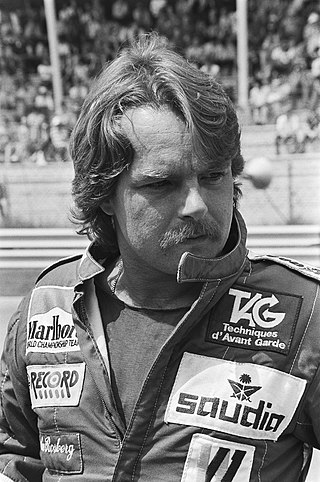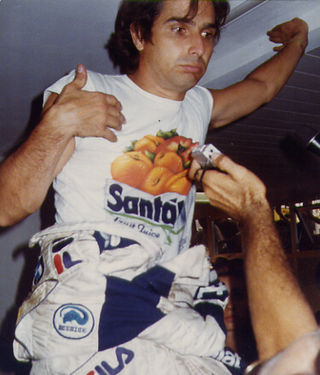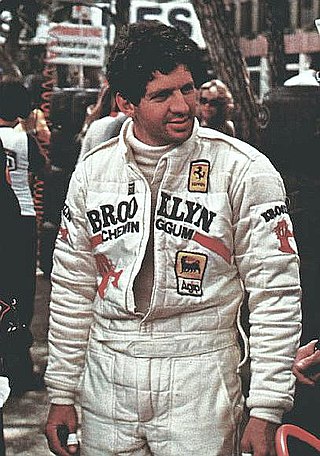
The 1990 San Marino Grand Prix was a Formula One motor race held on 13 May 1990 at Imola. It was the third race of the 1990 Formula One World Championship. The race was held over 61 laps of the 5.04-kilometre (3.13 mi) circuit for a race distance of 307.44 kilometres (191.03 mi).

The 1991 Japanese Grand Prix was a Formula One motor race held at Suzuka on 20 October 1991. It was the fifteenth round of the 1991 Formula One season. The 53-lap race was won by McLaren driver Gerhard Berger after he started from pole position. His teammate Ayrton Senna finished second and Riccardo Patrese was third for the Williams team. The race would mark Mclaren's last one-two finish for six years until the 1997 European Grand Prix.

The 1982 FIA Formula One World Championship was the 36th season of FIA Formula One motor racing. It included two competitions run over the course of the year, the 33rd Formula One World Championship for Drivers and the 25th Formula One World Championship for Constructors. The season featured sixteen rounds between 23 January and 25 September. The Drivers' Championship was won by Keke Rosberg and the Constructors' Championship by Scuderia Ferrari.

The 1981 FIA Formula One World Championship was the 35th season of FIA Formula One motor racing. It featured the 1981 Formula One World Championship for Drivers and the 1981 Formula One World Championship for Manufacturers, which were contested over a fifteen-race series that commenced on 15 March and ended on 17 October. The 1981 South African Grand Prix, as a non-championship race due to difficulties from the ongoing FISA–FOCA war, was open to Formula One entrants but was not part of the World Championship.

The 1980 Formula One season was the 34th season of FIA Formula One motor racing. It featured the 1980 World Championship of Drivers and the 1980 International Cup for F1 Constructors, which were contested concurrently from 13 January to 5 October over a fourteen-race series. The season also included one non-championship race, the Spanish Grand Prix.

The 1979 Formula One season was the 33rd season of FIA Formula One motor racing. It featured the 1979 World Championship of F1 Drivers and the 1979 International Cup for F1 Constructors which were contested concurrently over a fifteen-round series which commenced on 21 January 1979, and ended on 7 October 1979. The season also included three non-championship Formula One races.

Ivan Franco Capelli is an Italian broadcaster and former racing driver, who competed in Formula One from 1985 to 1993.

Didier Joseph Louis Pironi was a French racing driver and offshore powerboat racer, who competed in Formula One from 1978 to 1982. Pironi was runner-up in the Formula One World Drivers' Championship in 1982 with Ferrari, and won three Grands Prix across five seasons. In endurance racing, Pironi won the 24 Hours of Le Mans in 1978 with Renault.

Automobiles Gonfaronnaises Sportives was a small French racecar constructor that competed in various racing categories over a period of thirty years, including Formula One from 1986 to 1991.

Kauhsen was a Formula One constructor from Germany, founded by former sportscar driver Willi Kauhsen. The team started in Formula Two in 1976, purchasing Renault cars, and raced with an assortment of drivers with limited success. Kauhsen then entered the 1979 Formula One season, spending 1978 designing their own chassis with Cosworth engines. They participated in two World Championship Grands Prix with Gianfranco Brancatelli, failing to qualify on both occasions, before the team was shut down.

The Ferrari 126C is the car with which Ferrari raced from the 1981 through the 1984 Formula One season. The team's first attempt at a turbocharged Formula 1 car, it was designed by Mauro Forghieri and Harvey Postlethwaite. The engine chief engineer was Nicola Materazzi.

The Toro Rosso STR2 is the car with which the Scuderia Toro Rosso team competed in the 2007 Formula One season. It was unveiled on 13 February 2007 at the Circuit de Catalunya. The car is, controversially, a variant of the Red Bull RB3 chassis. It was initially driven by Vitantonio Liuzzi and Scott Speed, until Speed was replaced by Sebastian Vettel at the Hungaroring for the remainder of the season. The car in a modified form was also used to compete in the first five races of the 2008 Formula One season. The modified car was driven by Sébastien Bourdais, four-consecutive-time Champ Car winner, and Vettel. The STR2 was the first-ever Toro Rosso F1 car to use the mandatory 90-degree Formula One V8 engine configuration but Toro Rosso opted for the 2006-spec Ferrari 056 instead of the 2007-spec because of the 1-year old Toro Rosso customer engine policy and as a cost-saving measure.
The AGS JH22 was a Formula One racing car designed by Christian Vanderpleyn and used by the French AGS team in the 1987 Formula One season.

The Brawn BGP 001 is a Formula One world championship winning racing car, the design of which was started by Honda Racing, and completed and then built by the team after it was renamed to Brawn GP. It was the first and only Formula One car constructed by the Brawn GP team, and was used to contest the 2009 Formula One season. The car won eight out of the seventeen Grands Prix it competed in. It was notable for its unusual double diffuser, and its legality was disputed, though it was ultimately deemed legal by the FIA.
Leyton House Racing was a Formula One constructor that raced in the 1990 and 1991 seasons.

The JH23 was a Formula One car built and raced by the AGS team for the 1988 Formula One season. It was powered by the Ford Cosworth DFZ engine. A single car was entered, driven by experienced Frenchman Philippe Streiff.

The Leyton House CG911 was a Formula One racing car designed by Chris Murphy and Gustav Brunner for the 1991 Formula One season. Unlike its CG901 predecessor, which used a Judd EV V8 engine, the CG911 used an Ilmor 2175A V10 engine. Leyton House Racing initially started the 1991 season with Maurício Gugelmin and Ivan Capelli as their drivers, as they had in 1990, but Karl Wendlinger replaced Capelli for the final two races of the season. For 1992, when Leyton House renamed themselves as March F1, the CG911 was updated to the March CG911B specification, with Wendlinger, Jan Lammers, Paul Belmondo and Emanuele Naspetti all sharing driving duties. Although March initially intended to run the CG911C in 1993 with Lammers and Jean-Marc Gounon, the team folded and they did not compete that year.
The JH24 was a Formula One car built and raced by the AGS team for the 1989 Formula One season. It was powered by the Ford Cosworth DFR engine. The car only managed to qualify for one race. The cars were driven by Gabriele Tarquini and Yannick Dalmas, who replaced Joachim Winkelhock in the middle of the 1989 season.
The AGS JH15 was an open-wheel race car intended for Formula Two, designed, developed, and built by French racing team and constructor AGS, in 1978. The car ran and competed in individual Formula Three motor races for four years, until 1981. It was also the team's first Formula Two race car chassis, after a long period of building Formula Three cars for junior categories.

The EuroBrun ER189B is the last Formula 1 single-seater entered by the EuroBrun Racing team in its final participation in the Formula 1 World Championship, in 1990.
















